Themed collection Zeolites and 3D Porous Solids

LTA zeolite membranes: current progress and challenges in pervaporation
Linde Type A (LTA) zeolite-based membranes have demonstrated excellent selectivity in pervaporation due to their unique structural framework and interaction with water.
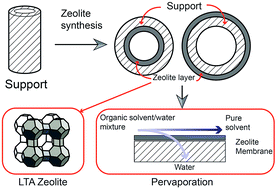
RSC Adv., 2017,7, 29520-29539
https://doi.org/10.1039/C7RA03341A
Amine-functionalized metal–organic frameworks: structure, synthesis and applications
We present a review on some recent studies on the syntheses, structures and properties of amine-functionalized MOFs, and highlight the benefits of amino functionality towards potential applications in CO2 capture, membranes and catalysis.

RSC Adv., 2016,6, 32598-32614
https://doi.org/10.1039/C6RA01536K
A critical review on recent polymeric and nano-enhanced membranes for reverse osmosis
Current and recent advances in polymeric and nano-enhanced membrane developments for reverse osmosis are reported in terms of membrane performance and fouling.
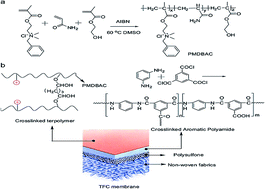
RSC Adv., 2016,6, 8134-8163
https://doi.org/10.1039/C5RA17221G
Template mediated and solvent-free route to a variety of UiO-66 metal–organic frameworks
A green and cost-effective process for UiO-66 synthesis with a facile and efficient solvent-free template oriented route.

RSC Adv., 2016,6, 102968-102971
https://doi.org/10.1039/C6RA23947A
Coke suppression in MTO over hierarchical SAPO-34 zeolites
Hierarchical SAPO-34 crystals were synthesized by a facile TEAOH etching post-treatment for the first time.

RSC Adv., 2016,6, 28787-28791
https://doi.org/10.1039/C6RA02282K
Effect of relative humidity on the gas transport properties of zeolite A/PTMSP mixed matrix membranes
CO2 permeability of zeolite A/PTMSP MMM increases with water content in the system, enhancing CO2/N2 and CO2/CH4 selectivities of PTMSP.
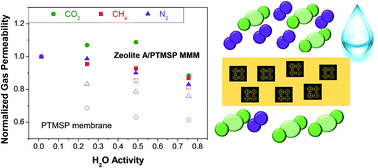
RSC Adv., 2018,8, 3536-3546
https://doi.org/10.1039/C7RA13039B
Retracted Article: Anti-cancer activity of hierarchical ZSM-5 zeolites synthesized from rice-based waste materials
We report the organic template-free synthesis of hierarchical ZSM-5 zeolite using waste materials, by a simple hydrothermal method and their excellent anti-cancer activity against A549 human lung epithelial cell lines.
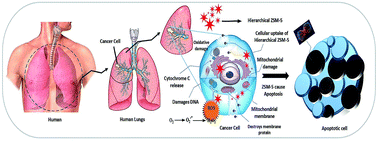
RSC Adv., 2018,8, 481-490
https://doi.org/10.1039/C7RA11763A
Screening metal–organic frameworks for mixture separations in fixed-bed adsorbers using a combined selectivity/capacity metric
For screening purposes, mixture separations with MOFs are evaluated on the basis of a combined selectivity/capacity metric.
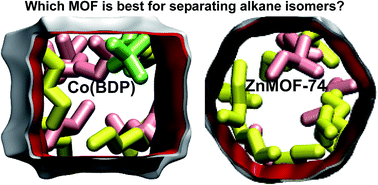
RSC Adv., 2017,7, 35724-35737
https://doi.org/10.1039/C7RA07363A
Effect of pyrazolium-derived compounds as templates in zeolite synthesis
Novel diquaternary pyrazolium templates with different spatial sizes have unique effects on zeolite phase selectivity and macromorphology.
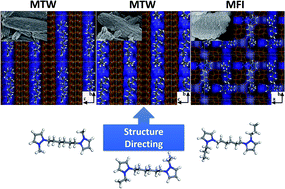
RSC Adv., 2017,7, 23272-23278
https://doi.org/10.1039/C7RA02864D
Highly selective synthesis of large aromatic molecules with nano-zeolite: beyond the shape selectivity effect
We report a combination of the shape selectivity effect of zeolites and external surface alkylation to produce larger molecules.

RSC Adv., 2017,7, 14309-14313
https://doi.org/10.1039/C6RA28844H
Efficient production of acrylic acid by dehydration of lactic acid over BaSO4 with crystal defects
Crystal defects in BaSO4 catalyst provide acid sites that catalyze the dehydration of lactic acid to acrylic acid.

RSC Adv., 2017,7, 10278-10286
https://doi.org/10.1039/C6RA28429A
Integration of nanosized ZIF-8 particles onto mesoporous TiO2 nanobeads for enhanced photocatalytic activity
Hybrid TiO2/ZIF-8 nanobeads have been prepared by decorating the surface of mesoporous TiO2 spheres with ZIF-8 nanoparticles and enhanced photocatalytic activity of Cr(VI) reduction than pristine TiO2 beads due to their hybrid nanostructures.
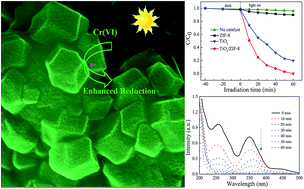
RSC Adv., 2017,7, 8004-8010
https://doi.org/10.1039/C6RA28277F
Synthesis of a multi-branched dandelion-like SAPO-11 by an in situ inoculating seed-induced-steam-assisted conversion method (SISAC) as a highly effective hydroisomerization support
A dandelion-like SAPO-11 with multiple branches was fabricated by seed-induced-steam-assisted conversion, which combined an in situ inoculating seed method (the initial gel pre-crystallized at 433 K for 24 h) and steam-assisted conversion process.

RSC Adv., 2017,7, 4656-4666
https://doi.org/10.1039/C6RA26522G
Synthesis of graphene oxide/polyimide mixed matrix membranes for desalination
Graphene oxide (GO) was incorporated into polyimide (PI) to fabricate GO/PI mixed matrix membranes (MMMs), which show a high water flux (36.1 kg m−2 h−1) and a high salt rejection (99.9%) for desalination of 3.5 wt% seawater at 90 °C.

RSC Adv., 2017,7, 2211-2217
https://doi.org/10.1039/C6RA24974D
Synthesis of a novel polyester building block from pentoses by tin-containing silicates
C5-Sugars form a new bio-monomer (trans-2,5-dihydroxy-3-pentenoic acid methyl ester), which can undergo enzymatic copolymerization with E6-HH to form multifunctional polymers.

RSC Adv., 2017,7, 985-996
https://doi.org/10.1039/C6RA26708D
Effect of the Si/Al ratio on the performance of hierarchical ZSM-5 zeolites for methanol aromatization
A series of hierarchical ZSM-5 zeolites with different Si/Al ratios were successfully prepared using a seed-deduced method and the addition of organosilicone reagents into the medial synthesis system.
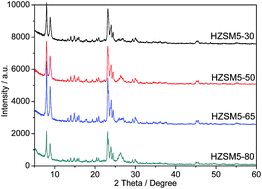
RSC Adv., 2016,6, 83581-83588
https://doi.org/10.1039/C6RA17084F
Conversion of methanol to propylene over nano-sized ZSM-5 zeolite aggregates synthesized by a modified seed-induced method with CTAB
Nano-sized ZSM-5 zeolite aggregates with mesopores and high catalytic activity were prepared by a modified seed-induced method using silicate-1 as seeds without additional templates in the presence of a trace amount of CTAB.

RSC Adv., 2016,6, 76642-76651
https://doi.org/10.1039/C6RA14753D
Lanthanide metal–organic frameworks based on a 1,2,3-triazole-containing tricarboxylic acid ligand for luminescence sensing of metal ions and nitroaromatic compounds
A series of novel 3D lanthanide MOFs based on unsymmetrical 1,2,3-triazole-containing tricarboxylic acid ligand (H3TAIP) has been synthesized. Compound 1 [Tb(TAIP)(DMF)2] exhibits selective detection of 4-nitrotoluene and Fe3+ ion.

RSC Adv., 2016,6, 57828-57834
https://doi.org/10.1039/C6RA06303A
Methanol to gasoline over zeolite ZSM-5: improved catalyst performance by treatment with HF
Zeolite ZSM-5 (SiO2/Al2O3 = 50) has been treated with hydrofluoric acid (HF) solutions, characterized with many techniques and studied in the conversion of methanol to gasoline (MTG).
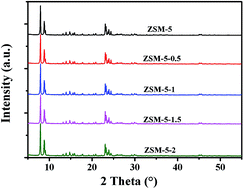
RSC Adv., 2016,6, 58586-58593
https://doi.org/10.1039/C6RA14513B
An unusual (4,4)-connected 3D porous cadmium metal–organic framework as a luminescent sensor for detection of nitrobenzene
The MOF 1 shows an unusual (4,4)-connected 3D porous network. The high quenching efficiency of 1 is up to 98.2% at 160 ppm NBZ. 1 displays highly selectivity, sensitivity and recyclability in the detection of nitrobenzene.

RSC Adv., 2016,6, 56035-56041
https://doi.org/10.1039/C6RA10664A
Structure–performance relationships of MnO2 nanocatalyst for the low-temperature SCR removal of NOX under ammonia
To investigate the corresponding relationship between catalytic efficiency and structure, MnO2 nanomaterials (nanospheres, nanosheets, nanorods) have been prepared successfully, and were thoroughly characterized by SEM and TEM.
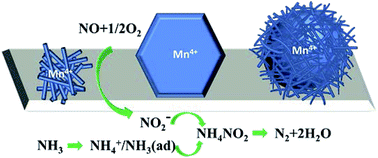
RSC Adv., 2016,6, 54926-54937
https://doi.org/10.1039/C6RA03108K
MOF-derived NixCo1−x(OH)2 composite microspheres for high-performance supercapacitors
NixCo1−x(OH)2 composite microspheres are successfully synthesized with the assistance of alkali solution by employing a bimetallic Co–Ni–MOF as both the precursor and the self-sacrificing template, demonstrating excellent electrochemical performance.
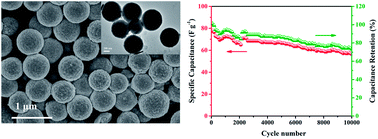
RSC Adv., 2016,6, 49478-49486
https://doi.org/10.1039/C6RA03992H
A Zn-MOF constructed from electron-rich π-conjugated ligands with an interpenetrated graphene-like net as an efficient nitroaromatic sensor
A π-electron conjugated ligand has been employed in a Zn-MOF efficient fluorescent sensor for determining electron-deficient nitroaromatics.

RSC Adv., 2016,6, 45475-45481
https://doi.org/10.1039/C6RA00524A
Cu–BTC@cotton composite: design and removal of ethion insecticide from water
Pesticide removal from wastewater is of significant general benefit to protect of humans from the effect of pollution.
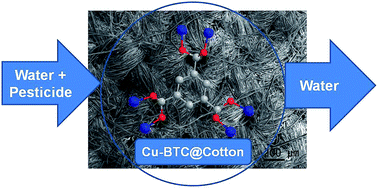
RSC Adv., 2016,6, 42324-42333
https://doi.org/10.1039/C6RA04719J
Luminescent sensing from a new Zn(II) metal–organic framework
The title compound is a potential candidate for developing novel luminescence sensors for the selective sensing of nitrobenzene which can be deployed for explosives, Fe3+ and organic dyes.

RSC Adv., 2016,6, 31161-31166
https://doi.org/10.1039/C6RA01709F
Anionic metal–organic framework hybrids: functionalization with lanthanide ions or cationic dyes and fluorescence sensing of small molecules
An anionic metal–organic framework, [HDMA]2[Zn2(BDC)3(DMA)]·6DMF is modified by lanthanides and they exhibit selective adsorption ability to cationic dyes. RhB@1 has a rapidest response and realizes sensing acetone and aniline.

RSC Adv., 2016,6, 28165-28170
https://doi.org/10.1039/C6RA02043G
A new triazine functionalized luminescent covalent organic framework for nitroaromatic sensing and CO2 storage
A hexagonal COF has been designed via Schiff-base condensation reaction between 1,3,5-tris-(4-aminophenyl)triazine and 1,3,5-triformylphloroglucinol. It showed excellent sensing behavior towards nitroaromatic compounds through fluorescence quenching and excellent CO2 uptake.

RSC Adv., 2016,6, 28047-28054
https://doi.org/10.1039/C6RA01717G
Highly efficient simultaneous ultrasonic-assisted adsorption of methylene blue and rhodamine B onto metal organic framework MIL-68(Al): central composite design optimization
In this work, metal organic framework (MIL-68(Al)), was synthesized by a simple, fast and low-cost process for simultaneous removal of methylene blue and Rhodamine B, regarded to be toxic and even carcinogenic, from aqueous solution.

RSC Adv., 2016,6, 27416-27425
https://doi.org/10.1039/C5RA28052D
White-light emitting materials with tunable luminescence based on steady Eu(III) doping of Tb(III) metal–organic frameworks
White-light emission materials were successfully acquired based on a sequence of isostructural co-doped lanthanide coordination polymers [EuxTb1−x(Hbtca)(phen)] (0 ≤ x ≤ 1).

RSC Adv., 2016,6, 25689-25694
https://doi.org/10.1039/C6RA01931E
HPLC enantioseparation on a homochiral MOF–silica composite as a novel chiral stationary phase
Using enantiopure (R)-2,2′-dihydroxy-1,1′-binaphthalene-6,6′-dicarboxylic acid as a starting material, we prepared three homochiral MOFs that were further used as chiral stationary phases for HPLC to separate the enantiomers.

RSC Adv., 2016,6, 21293-21301
https://doi.org/10.1039/C5RA26520G
Synthesis of a novel and stable reduced graphene oxide/MOF hybrid nanocomposite and photocatalytic performance for the degradation of dyes
A simple and facile solvothermal method is developed for the preparation of a reduced graphene oxide/NH2-MIL-125(Ti) (rGO–NMTi) hybrid nanocomposite photocatalyst with large specific surface area and thermal stability.

RSC Adv., 2016,6, 17873-17879
https://doi.org/10.1039/C5RA25689E
Evolution of confined species and their effects on catalyst deactivation and olefin selectivity in SAPO-34 catalyzed MTO process
A “three sections, three periods” mechanism is proposed to discuss the formation and transformation of confined species and its effects on catalyst deactivation and product selectivity.

RSC Adv., 2016,6, 17651-17658
https://doi.org/10.1039/C5RA22424A
Photocatalytic degradation of binary mixture of toxic dyes by HKUST-1 MOF and HKUST-1-SBA-15 in a rotating packed bed reactor under blue LED illumination: central composite design optimization
A new composite of mesoporous materials, HKUST-1 metal organic framework and SBA-15, was synthesized and applied to the simultaneous visible-light-driven photodegradation of a binary dye mixture of safranin O and malachite green.
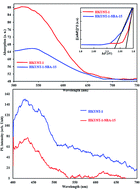
RSC Adv., 2016,6, 17204-17214
https://doi.org/10.1039/C5RA24564H
Hydrolytically stable ZIF-8@PDMS core–shell microspheres for gas–solid chromatographic separation
Metal organic frameworks (MOFs) with exceptionally high surface areas, shape selectivity and availability of multiple active sites are suitable materials to serve as solid stationary phase for chromatographic applications.

RSC Adv., 2016,6, 13426-13432
https://doi.org/10.1039/C5RA26077A
A lanthanide metal–organic framework (MOF-76) for adsorbing dyes and fluorescence detecting aromatic pollutants
A series of nano-sized luminescent lanthanide metal–organic frameworks (Ln-MOFs) are developed for application in dye adsorption and fluorescence sensing for monoaromatic hydrocarbons (BTEX).
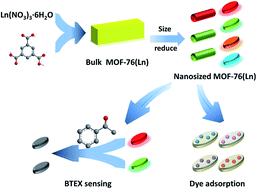
RSC Adv., 2016,6, 11570-11576
https://doi.org/10.1039/C5RA23681A
MOF–polymer enhanced compatibility: post-annealed zeolite imidazolate framework membranes inside polyimide hollow fibers
Zeolitic imidazolate frameworks and polyimide supports improved their affinity during thermal annealing and therefore the separation performance of the membrane.

RSC Adv., 2016,6, 5881-5889
https://doi.org/10.1039/C5RA26076K
Surface defection reduces cytotoxicity of Zn(2-methylimidazole)2 (ZIF-8) without compromising its drug delivery capacity
Surface defection incurs bond breakage and unsaturated Zn-sites and N-sites on the external surface of ZIF-8 particles. These bonds in turn bind H2O molecules in an aqueous environment, converting ZIF-8 from hydrophobic to hydrophilic.
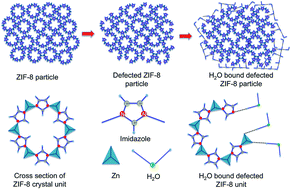
RSC Adv., 2016,6, 4128-4135
https://doi.org/10.1039/C5RA24336J
Titanium incorporated with UiO-66(Zr)-type Metal–Organic Framework (MOF) for photocatalytic application
Dual function of the adsorption and photodegradation for the methylene blue removal over the UiO-66(Ti) nanocomposites.
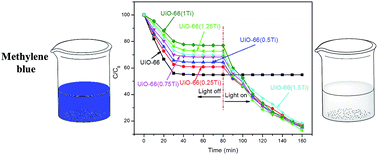
RSC Adv., 2016,6, 3671-3679
https://doi.org/10.1039/C5RA24135A